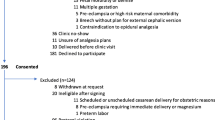Abstract
Relatively little is known about mental health and labor pain. The aim of this study was to assess if self-rated antenatal depressed mood and anxiety are associated with pain-related behaviors and self-reported labor pain. We also wanted to replicate our previous finding of altered labor pain behavior in carriers of a specific guanosine triphosphate cyclohydrolase 1 gene (GCH1) haplotype. Ninety-nine women in gestational weeks 37 to 40 filled out questionnaires on depression and anxiety symptoms and later rated their labor pain by use of visual analog scales. Each subject was also genotyped for GCH1. Following adjustment for relevant confounders, women who arrived early to the delivery unit (cervical dilation <5 cm) had a significantly higher antenatal Montgomery-Åsberg Depression Rating Scale (MADRS-S) score, p < 0.05, than late arrivers (cervical dilation >5 cm). Women with increased Spielberger State-Trait Anxiety Inventory (STAI-T) scores reported higher self-rated pain prior to labor analgesia, p < 0.05, than women with low STAI-T scores. No association between the GCH1 pain-protective haplotype and cervical dilation was found, but a previously demonstrated association with increased use of second-line analgesia was confirmed. Depressed mood during pregnancy is associated with early arrival to the delivery department, whereas antenatal anxiety is associated with increased self-rated pain prior to labor analgesia.
Similar content being viewed by others
References
Andersson L, Sundstrom-Poromaa I et al (2004) Implications of antenatal depression and anxiety for obstetric outcome. Obstet Gynecol 104(3):467–476
Barnett B, Parker G (1985) Professional and non-professional intervention for highly anxious primiparous mothers. Br J Psychiatry 146:287–293
Brown ST, Campbell D et al (1989) Characteristics of labor pain at two stages of cervical dilation. Pain 38(3):289–295
Capogna G, Camorcia M et al (2010) Multidimensional evaluation of pain during early and late labor: a comparison of nulliparous and multiparous women. Int J Obstet Anesth 19(2):167–170
Curzik D, Jokic-Begic N (2011) Anxiety sensitivity and anxiety as correlates of expected, experienced and recalled labor pain. J Psychosom Obstet Gynaecol 32(4):198–203
Dabo F, Gronbladh A et al (2010) Different SNP combinations in the GCH1 gene and use of labor analgesia. Mol Pain 6:41
Escott D, Slade P et al (2009) Preparation for pain management during childbirth: the psychological aspects of coping strategy development in antenatal education. Clin Psychol Rev 29(7):617–622
Evans J, Heron J et al (2001) Cohort study of depressed mood during pregnancy and after childbirth. BMJ 323(7307):257–260
Ginya H, Asahina J et al (2007) Development of the Handy Bio-Strand and its application to genotyping of OPRM1 (A118G). Anal Biochem 367(1):79–86
Grant KA, McMahon C et al (2008) Maternal anxiety during the transition to parenthood: a prospective study. J Affect Disord 108(1–2):101–111
Landau R, Kern C et al (2008) Genetic variability of the mu-opioid receptor influences intrathecal fentanyl analgesia requirements in laboring women. Pain 139(1):5–14
Lang AJ, Sorrell JT et al (2006) Anxiety sensitivity as a predictor of labor pain. Eur J Pain 10(3):263–270
Lotsch J, Belfer I et al (2007) Reliable screening for a pain-protective haplotype in the GTP cyclohydrolase 1 gene (GCH1) through the use of 3 or fewer single nucleotide polymorphisms. Clin Chem 53(6):1010–1015
Melzack R, Kinch R et al (1984) Severity of labour pain: influence of physical as well as psychologic variables. Can Med Assoc J 130(5):579–584
Montgomery SA, Asberg M (1979) A new depression scale designed to be sensitive to change. Br J Psychiatry 134:382–389
Perkin MR, Bland JM et al (1993) The effect of anxiety and depression during pregnancy on obstetric complications. Br J Obstet Gynaecol 100(7):629–634
Pettersson FD, Gronbladh A et al (2012) The A118G single-nucleotide polymorphism of human mu-opioid receptor gene and use of labor analgesia. Reprod Sci 19(9):962–967
Pieters MS, Jennekens-Schinkel A et al (1992) Self-selection for personality variables among healthy volunteers. Br J Clin Pharmacol 33(1):101–106
Rouhe H, Salmela-Aro K et al (2011) Mental health problems common in women with fear of childbirth. BJOG 118(9):1104–1111
Rowlands S, Permezel M (1998) Physiology of pain in labour. Baillieres Clin Obstet Gynaecol 12(3):347–362
Smith R, Cubis J et al (1990) Mood changes, obstetric experience and alterations in plasma cortisol, beta-endorphin and corticotrophin releasing hormone during pregnancy and the puerperium. J Psychosom Res 34(1):53–69
Spielberger CD (1983) State-trait anxiety inventory for adults. Sampler Set, Manual Set, Scoring Key Palo Alto, Consulting Psychologists Press Inc, California USA
Tegeder I, Costigan M et al (2006) GTP cyclohydrolase and tetrahydrobiopterin regulate pain sensitivity and persistence. Nat Med 12(11):1269–1277
Waldenstrom U, Bergman V et al (1996) The complexity of labor pain: experiences of 278 women. J Psychosom Obstet Gynaecol 17(4):215–228
Sources of financial support
This project was financed by grants from the Söderström-Königska Foundation, the Uppsala-Örebro Regional Research Council, Precision System Science (PSS), and General Maternity Hospital Foundation and from the Swedish Science Research Council.
Compliance with ethical standards
The study procedures were in accordance with ethical standards for human experimentation, and the study was approved by the Independent Research Ethics Committee, Uppsala University. Written informed consent was obtained from each woman before inclusion.
Conflict of interest
The authors declare that they have no competing interests.
Author information
Authors and Affiliations
Corresponding author
Rights and permissions
About this article
Cite this article
Pettersson, F.D., Hellgren, C., Nyberg, F. et al. Depressed mood, anxiety, and the use of labor analgesia. Arch Womens Ment Health 19, 11–16 (2016). https://doi.org/10.1007/s00737-015-0572-6
Received:
Accepted:
Published:
Issue Date:
DOI: https://doi.org/10.1007/s00737-015-0572-6




